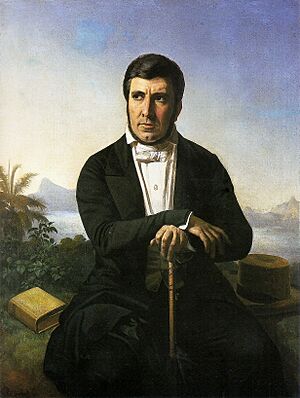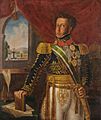Manuel de Araújo Porto-Alegre, Baron of Santo Ângelo facts for kids
Quick facts for kids
Baron of Santo Ângelo
|
|
|---|---|

Porto-Alegre by Ferdinand Krumholz, c. 1848
|
|
| Born | Manuel José de Araújo 29 November 1806 Rio Pardo, Colonial Brazil |
| Died | 30 December 1879 (aged 73) Lisbon, Kingdom of Portugal |
| Pen name | Tibúrcio do Amarante |
| Occupation | Writer, painter, caricaturist, professor, diplomat, architect |
| Alma mater | Imperial Academy of Fine Arts |
| Period | 19th century |
| Genre | Poetry, theatre, painting, drawing, editorial cartoon |
| Literary movement | Romanticism |
| Spouse | Ana Paulina Delamare |
| Children | Carlota Porto-Alegre Paulo Porto-Alegre |
 Coat of Arms of the Baron of Santo Ângelo |
|
Manuel José de Araújo Porto-Alegre, Baron of Santo Ângelo (born November 29, 1806 – died December 30, 1879) was a very important Brazilian artist and writer. He was a Romantic writer, a painter, and even an architect. He also worked as a diplomat and a professor.
Manuel Porto-Alegre is known as one of the first Brazilian editorial cartoonists. These are artists who draw funny pictures about news and politics. He is honored as the patron of the 32nd chair of the Brazilian Academy of Letters.
Contents
Life Story of Manuel Porto-Alegre
Manuel José de Araújo was born in Rio Pardo, Rio Grande do Sul, Brazil. His parents were Francisco José de Araújo and Francisca Antônia Viana. During Brazil's fight for independence, he changed his name to Manuel de Araújo Pitangueira. He did this for "nativist reasons," meaning he wanted a name that sounded more Brazilian. Later, he changed it again to Manuel de Araújo Porto-Alegre.
In 1826, he moved to Rio de Janeiro. There, he studied painting with a famous artist named Jean-Baptiste Debret. This was at the Imperial Academy of Fine Arts. He also studied at the military academy and took courses in medicine and philosophy.
Travels and New Ideas
In 1831, Manuel left Brazil with Debret to travel in Europe. He wanted to improve his painting skills. In 1835, he visited Italy. There, he met Gonçalves de Magalhães, another Brazilian poet.
In 1837, Porto-Alegre and Magalhães started a magazine in France called Niterói. They worked on it with Francisco de Sales Torres Homem.
Teaching and Family Life
Also in 1837, Manuel became a history painting teacher. He taught at the Imperial Academy of Fine Arts until 1848. Then, he started teaching drawing at the military academy. This is when he began drawing his first caricatures.
In 1838, he married Ana Paulina Delamare. They had two children: Carlota Porto-Alegre and Paulo Porto-Alegre. Carlota later married the famous painter Pedro Américo. Paulo became a diplomat, someone who represents their country in other nations.
Working for the Emperor
In 1840, Emperor Pedro II named Manuel his official painter. Manuel decorated the emperor's palace in Petrópolis. He also worked on the emperor's wedding to Teresa Cristina of the Two Sicilies. He even decorated the emperor's coronation ceremony. Because of his work, he received special honors like the Order of Christ and the Order of the Rose.
Magazines and Publications
Manuel Porto-Alegre loved to start magazines. From 1843 to 1845, he worked with Gonçalves de Magalhães and Torres Homem again. They created a magazine called Minerva Brasiliense. In this magazine, he published his long poem Brasiliana.
In 1844, he and Torres Homem started a humor magazine called Lanterna Mágica. This is where he published many of his funny caricatures. In 1849, Porto-Alegre founded another magazine, Guanabara. He worked on it with Joaquim Manuel de Macedo and Gonçalves Dias. This magazine was very important for the Romantic movement in Brazil. It was published until 1856.
Public Service and Diplomacy
In 1852, Manuel Porto-Alegre entered politics. He became a substitute councilman in the Municipal Chamber of Rio de Janeiro. He helped with city planning and public health. He held this position until 1854. That year, he became the headmaster (director) of the Imperial Academy of Fine Arts. He led the academy until 1857.
In 1860, Porto-Alegre became a diplomat. He served as a consul for the Empire of Brazil in different countries. He worked in what are now Germany (Prussia and Saxony) and later in Portugal. He passed away in Lisbon, Portugal. His remains were brought back to Brazil in 1922.
In 1874, Emperor Pedro II gave him the special title of Baron of Santo Ângelo. He was also a member of the Brazilian Historic and Geographic Institute.
Manuel Porto-Alegre and Spiritism
In 1865, while in Dresden, Manuel Porto-Alegre wrote a letter to Joaquim Manuel de Macedo. Macedo was teaching Princess Isabel's children at the time. In the letter, Porto-Alegre shared that he had become a Spiritist. He believed he could receive messages from spirits. Princess Isabel even asked him about her "guardian spirit." This interesting letter, with 12 pages, is now kept at the Brazilian National Archives.
Manuel Porto-Alegre's Literary Works
Manuel Porto-Alegre wrote many different types of works.
Poetry
- Ode Sáfica (1830) — This poem was dedicated to his teacher, Jean-Baptiste Debret.
- Canto Inaugural (1855)
- Brasiliana (1863)
- Colombo (an epic poem — 1866)

Theater Plays
- Prólogo Dramático (1837)
- Angélica e Firmino (1845)
- A Destruição das Florestas (1845)
- A Estátua Amazônica (1851)
- A Restauração de Pernambuco (1852)
- A Noite de São João (1857)
- Cenas de Penafiel (1858)
- Os Judas (1859)
- O Prestígio da Lei (1859)
- Os Lobisomens (1862)
- Os Voluntários da Pátria (1877)
Fiction
- Excertos das Memórias e Viagens do Coronel Bonifácio do Amarante (1848) — He wrote this under the pen name Tibúrcio do Amarante.
Translations
Manuel Porto-Alegre also translated plays from other languages into Portuguese:
- Electra by Euripides (from Greek)
- Lucrèce Borgia by Victor Hugo (from French)
- Christine of Sweden by Alexandre Dumas (from French)
Famous Paintings by Manuel Porto-Alegre
-
Portrait of Pedro I of Brazil, an oil painting.
-
Brazilian Jungle, a watercolor painting.
See also
 In Spanish: Manuel de Araújo Porto-Alegre para niños
In Spanish: Manuel de Araújo Porto-Alegre para niños








